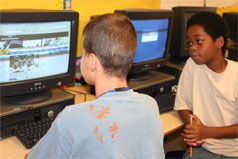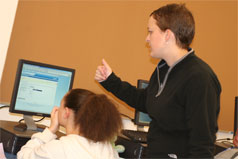

More of Wisconsin's
culture:
Ahead of the curve
 |
| Two students take advantage of the top-notch resources available to them at the Milwaukee Learning Labratory Institute.
Photo courtesy of Anne Shapiro |
By Anne Shapiro
Why everyone wants to live in a small town - until the small town gets big
An a-maize-ing energy alternative
Corn comes off the cob and into your fuel tank
Got grapes?
Meet two Wisconsin residents who have entered the international wine scene without leaving the state
Welcome to Hollywood, Wisconsin
New bill creates incentives for filmmakers to capture life and scenery in Dairy State
More than a decade after David Coyle answered “teacher” to the question, “What do you want to be when you grow up?” the 29-year-old UW-Milwaukee graduate paused outside the doorway of his first real teaching job. Starting six weeks into the school year, Coyle entered the same doorway two previous teachers had exited when they quit earlier that same year. He found himself in a volatile situation. The overcrowding in the social studies classroom at Casimir Pulaski High School in Milwaukee was further exacerbated by the immense amount of emotional baggage students brought with them to class.
A general apathy among students regarding their education hung heavily in the classroom. They had seen teachers who invested minimal energy into them, who quit mid-semester, who left the students with no real motivation to care.
He faced an arduous challenge but says, “I soon found out that the kids just wanted something stable.”
Milwaukee Public High Schools have been plagued by student violence, administrative ennui and according to the Manhattan Institute for Policy Research, a graduation rate of 45 percent -- the fifth-lowest among the 100 largest school districts in the nation. Milwaukee's problem is a stark contrast to the rest of Wisconsin, which has earned an 85 percent graduation rate, second only to New Jersey.
According to research by Jay P. Greene and Marcus A. Winters of the Manhattan Institute, the nation’s ten largest school districts, including Milwaukee, educate roughly eight percent of the high school population and fail to graduate more than 60 percent of students. Greene and Winters aren't able to pinpoint the causes of this trend, but they stress that these grave numbers should be a call to action: “Clearly, if the public is to improve high school graduation rates, it would do well to focus its efforts on the education provided in these urban areas.”
As an ambitious young teacher within one of these areas, Coyle saw a problem he wanted to fix, an opportunity to fix it, and he dove in. The opportunity came from a Gates Foundation grant, which made it possible for him to begin his plan.
Over the years, educators have attempted to ameliorate the city's public school problems with a barrage of band-aids, Coyle says. The latest treatment--the establishment of charter schools--seemed promising. Perhaps the new strategy is an antibiotic compared with the apple-a-day approach of past years. Funded through tax dollars, like any other public school, charter schools enjoy a greater level of autonomy in exchange for a higher level of accountability to the city, to funders, and most importantly, to students and their parents.
These parents and students were wary of a new school, so Coyle went the extra mile. He spent countless hours visiting the homes of prospective students all over the city. He says these families seemed initially surprised to hear from him, but he adds, “You’d go visit and you’d hear another story about how they weren’t happy with the big school their kid was at, or they weren’t happy with education in general and were looking for something else.”
The trips paid off. In September 2005, just three years after walking into his first job, Coyle stood in the doorway of his new school. It was housed in the corner of a middle school just a few miles from his former place of employment.
After a year-and-a-half of intense work, hundreds of hours of late-night and Saturday-morning planning meetings, teaching full time at Pulaski, and enduring cold shoulders from resentful colleagues whom he once regarded as friends, Coyle and a handful of former Pulaski teachers had managed to breathe new life into an ailing school district.
Their plan for the Milwaukee Learning Laboratory Institute (MLLI) lies in project-based learning, essentially taking material, studied in-depth not breadth, and applying it to real-world problems. The school’s name echoes the mission of its founders. “It’s really what the school is,” says Coyle. “It’s like a learning laboratory where we try to figure out why kids learn and how they learn so it’s kind of like our laboratory. So eventually we’ll perfect the learning process.” Teachers at this school take this idea to heart-and to the classroom.
On the wall of a study hall classroom hang posters outlining the definitions of sexual and aggravated assault, created by students as part of their latest project. Denise Payne, a shy ninth-grader from the often crime-ridden north side of Milwaukee sits by herself, engrossed in homework that may be all-too-real for her. “I like project-based learning,” she says quietly. “We doin' a project on crime. We see how much crime there is in Milwaukee and that stuff.” In a follow-up to this project, students search for solutions to the city’s problems.
Now in its second year of operation, MLLI’s freshman and sophomore classes have a total enrollment of 168, roughly doubling its first year's enrollment. Close to 50 percent of students are considered “at risk” by the state, a definition encompassing students who have a greater likelihood of dropping out, lag behind their peers in earned credits or struggle with basic skills like reading and mathematics. More than 80 percent of MLLI students live further than two miles from the school.
Coyle says his biggest challenge is getting parents, who often lack transportation or time, to become involved with a school so far from their homes.
Ninth-grader Terrell Jones rides the city bus for longer than an hour to get to class each morning. He says he likes the school, which his sister picked out for him, because class sizes are small, one of Coyle’s main goals in its creation.
With class sizes ranging from 20 to 25 students, nearly two-thirds the size of those at Pulaski, teachers have the opportunity to interact with each student personally. In a school where everyone knows everyone, students feel an increased sense of accountability. As science teacher Aaron Shapiro describes it, “because the school is new it’s still creating its own identity, and I think they really like the fact that they’re a part of it. It’s a very valuable tool to use when a kid says something and you have the opportunity to say ‘hey this is your school and you can do what you want’ and they really can.”
Sophomore Lance Orr has been a student at MLLI since its opening. As he researched his class’s project on equal rights, he shared his thoughts on the school. “It’s different from other schools, but that’s ‘cause it’s just starting out. It’s pretty cool we can mold it. We have more word in what happens.” Coyle hopes to expand on this sentiment.
Last year, after a prolonged incidence of graffiti in the school, Coyle and the other teachers incorporated ideas of community-building and ownership into their lessons. Within weeks the graffiti completely ceased. “I want them to get to a point where they kind of police themselves,” says Coyle. “That’s almost like an art form. If you can get them to that point then you have a pretty good school.”
A vital aspect to the school’s success lies in its teachers. As Coyle describes it, “The teachers, where we’re at right now, they bend over backwards for the kids.” A tardy student who missed breakfast can count on Coyle to rummage through the school kitchen to find some food, and students know he always carries a few extra bags of crackers for mid-morning snacks. Lost bus passes are replaced without question. Many teachers stick around after school for those kids who don’t want to leave. “Little things like that you don’t think about, but then a lot of people don’t do that for these kids,” says Coyle. Shapiro, who taught with Coyle at Pulaski before leaving to join the MLLI team this past spring, agrees. “In general, teachers and what not are some of the most caring and supportive people that these kids have. A lot of them come to school ‘cause everything else in their life kind of sucks, you know, to put it bluntly.”
Attendance seems to reflect this. Students want to come to school and get involved. The school's attendance for September was 85 percent, higher than Pulaski’s, which hovers around 80 percent.
Coyle still faces challenges daily – attendance being one of his biggest ongoing struggles. But patrolling the halls of the school he helped create, he can peer through doorways into classrooms, not sardine cans. Two-and-a-half years from now, when the first graduating class receives their diplomas, they will leave high school having gained an education that will leave plenty of doors wide open.
 |
|
An instructor at the Learning Labratory Institute guides a student through an in-class activity. Photo courtesy of Anne Shapiro |
home | alternatives | fulfillment | life change | climate | lifestyle
about | subscribe | contact | advertise | site map
_____________________________________________________________
(c) curb magazine 2006